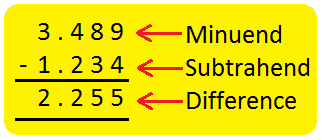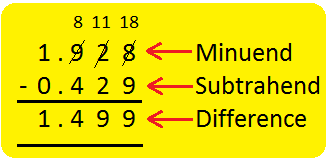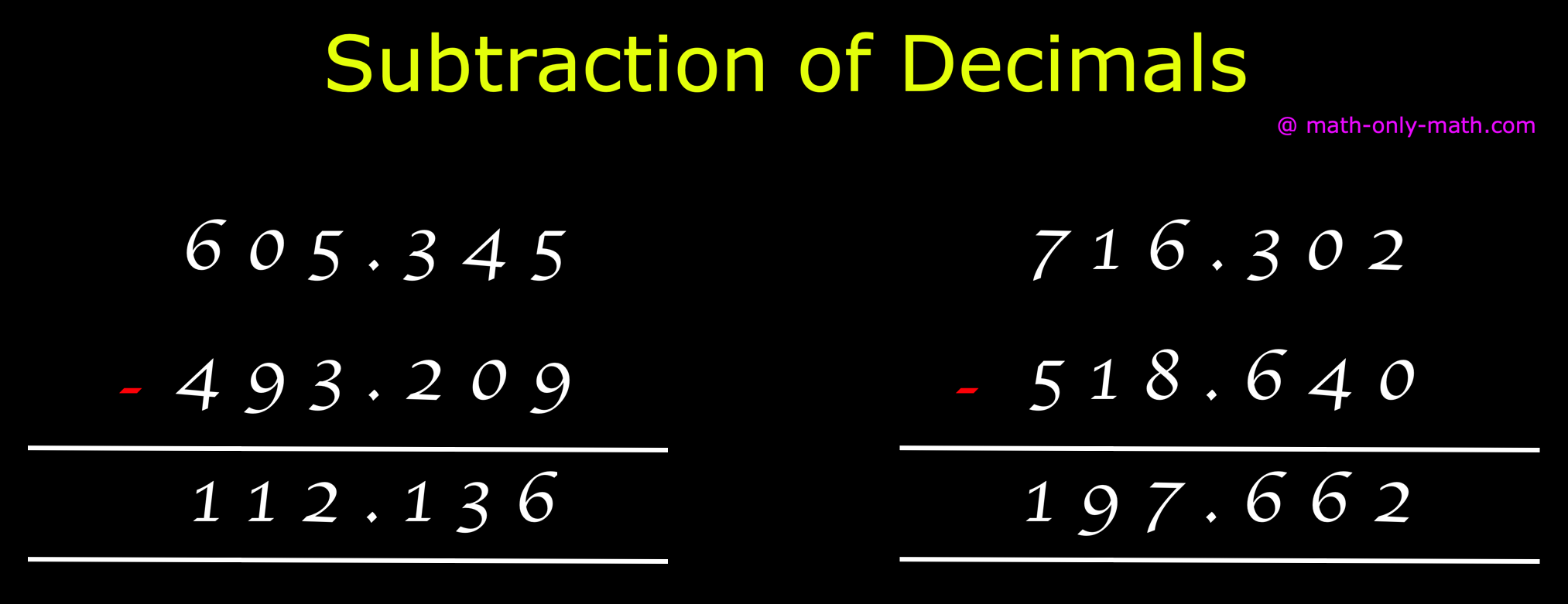Subscribe to our ▶️ YouTube channel 🔴 for the latest videos, updates, and tips.
Subtraction of Decimals
We will discuss here about the subtraction of decimals. Decimals are subtracted in the same way as we subtract ordinary numbers. We arrange the digits in columns and then subtract one decimal from the other decimal as required.
How to Subtract Decimals?
We subtract the decimals as we subtract the whole numbers. Before subtracting decimals, we arrange the digits in column as per their place value. If there is no digit for any place. It can be taken as zero (0).
Let us consider some of the examples on subtracting decimals.
1. Subtract 3.489 - 1.234
|
Step I: Write the number vertically aligning on the decimal points. Step II: Subtract the thousandths. 9 – 4 = 5. Write 5 under thousandths. Step III: Subtract the hundredths. 8 – 3 = 5. Write 5 under hundredths. Step IV: Subtract the tenths. 4 – 2 = 2. Write 2 under tenths. Step V: Subtract the ones. 3 – 1 = 2. Write 2 under ones. |
2. Subtract 1.928 – 0.429
|
Step I: Write the number vertically aligning on the decimal points. Step II: Regroup and subtract the thousandths. 18 – 9 = 9. Write 9 under thousandths. Step III: Regroup and subtract the hundredths. 11 – 2 = 9. Write 9 under hundredths. Step IV: Regroup and subtract the tenths. 8 – 4 = 4. Write 4 under tenths. Step V: Subtract the ones. 1 – 0 = 1. Write 1 under ones. |
3. Subtract 2.569 from 8.425
We arrange the digits of decimals in columns and subtract the smaller decimal from the greater one. We ensure that the decimal points are in the same column.
8 . 4 2 5
- 2 . 5 6 9
5 . 8 5 6
4. Subtract 13.725 from 40.000
We arrange the digits of decimals in columns and then we subtract one decimal from the other as usual.
4 0 . 0 0 0
- 1 3 . 7 2 5
2 6 . 2 7 5
5. Subtract 314.328 from 823.019
Subtract as required and ensure that the decimal points are in the same column.
8 2 3 . 0 1 8
- 3 1 4 . 3 2 8
5 0 8 . 6 9 0
6. Subtract 247.63 from 839.84
8 3 9 . 8 4
- 2 4 7 . 6 3
5 9 2 . 2 1
7. Subtract the following fractions:
(i) Subtract 3.7 from 6.92.
(ii) Subtract 2.4 from 18.8.
Solution:
(i) Subtract 3.7 from 6.92.
6 . 92
- 3 . 7
_______
or
6 . 92
- 3 . 70
3 . 22
(ii) Subtract 2.4 from 18.8.
18 . 8
- 2 . 4
_______
or
18 . 8
- 02 . 4
16 . 4
Worksheet on Subtraction of Decimals:
Questions and Answers on Subtraction of Decimals:
I. Subtract the following:
(i) 36.24 – 14.12 = ..............
(ii) 23.005 – 16.004 = ..............
(iii) 45.36 – 28.29 = ..............
(iv) 318.42 – 126.31 = ..............
(v) 240.05 – 169.35 = ..............
(vi) 999.009 – 888.118 = ..............
Answer:
I. (i) 22.12
(ii) 7.001
(iii) 17.07
(iv) 192.11
(v) 70.70
(vi) 110.891
II. Find the difference of the following decimals.
|
(i) |
3 0 8 . 5 9 9 - 9 9 . 6 9 4_ ______________ |
(ii) |
2 2 5 . 2 8 6 - 1 2 4 . 8 4 0_ ______________ |
|
(iii) |
4 6 3 . 8 2 6 - 2 9 4 . 9 0 9_ ______________ |
(iv) |
8 8 3 . 7 3 7 - 4 2 5 . 9 4 8_ ______________ |
|
(v) |
4 4 6 . 0 0 9 - 1 8 8 . 1 9 9_ ______________ |
(vi) |
6 0 5 . 3 4 5 - 4 9 9 . 6 7 6_ ______________ |
Answer:
II. (i) 208.905
(ii) 100.446
(iii) 168.917
(iv) 457.789
(v) 257.81
(vi) 105.669
From Subtraction of Decimals to HOME PAGE
Didn't find what you were looking for? Or want to know more information about Math Only Math. Use this Google Search to find what you need.





New! Comments
Have your say about what you just read! Leave me a comment in the box below. Ask a Question or Answer a Question.